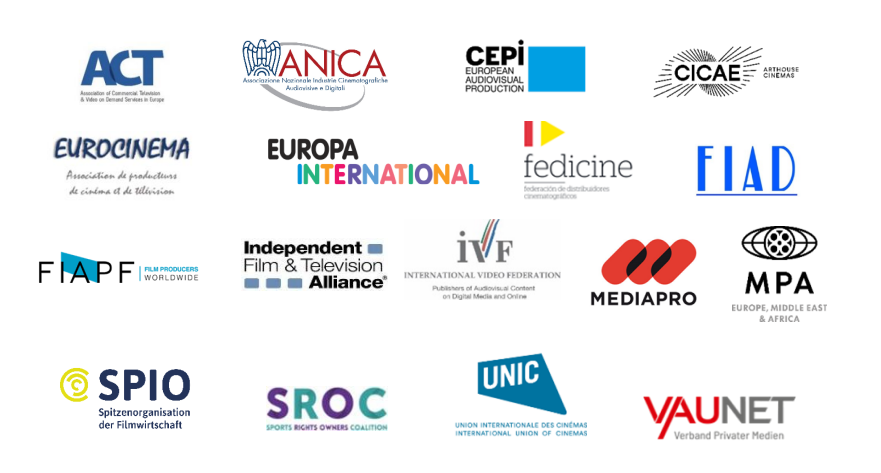Responding to evolving audience demand and expectations regarding culturally diverse films and audiovisual content and diverse ways to enjoy such content is a daily concern of the film and audiovisual sector in Europe. For more than 20 years, our sector has embraced the opportunities created by digital technologies in offline and online exploitation and we will continue to do so. At stake is the ability for audiences to benefit from a diversity of content produced and distributed across multiple distribution channels offline and online, all at various price points.
In this context the undersigned organisations, representing key stakeholders in the film and audiovisual creation, production and distribution value chain welcome the findings of the latest European Audiovisual Observatory (EAO) study on the “Circulation of European films on VOD and in cinemas”¹ complementing the EAO’s Yearbook 2021/2022 Key Trends².
The EAO data collection confirms a wide, market-driven evolution in the growing availability and circulation of European film titles in cinemas and online, and further highlights the interlinked and interdependent creative and business interests in the film and audiovisual value chain. The following EAO findings are particularly relevant:
- European audiences have access to over 8 500 European films on VOD in their countries on average. Of these, 82% (~7000) originate in other European countries.
This confirms that the increase in European non-national online distribution services operating outside their country of establishment in the EU-27 has now reached a point where any potential demand for European non-national titles is well-met through the diversity of titles and services on offer in-territory.
- VOD roll-out increased by 71% the availability of European non-national films. Of these, 63% of films were available in more than 10 countries on VOD, 31% in 3 to 9 countries, and only 6% were available in 1 or 2 countries.
- 60% of all EU content available on TVOD services is EU non-national. For SVOD services, the share of EU non-national content among all EU content is 76%³.
This is testimony to the fact that the EU is seen by the film and audiovisual sector as a marketplace with significant opportunities for future growth and a confirmation of the high value attached to European productions in distributors’ investment and market strategies.
These figures also illustrate that both private and public players in the film and audiovisual sector in Europe have invested heavily over the past decade to achieve the access/availability goals set in the 2020 EU Media and Audiovisual Action Plan’s Action 7.
This achievement would not have been possible without the crucial political and financial incentives of the European, national or regional public authorities that have allowed the film and audiovisual sector to raise massive private investments for new productions, marketing and distribution as well as deploying new digital technologies to the benefit of industry and audiences alike.
While the objectives set out in the MAAP’s Action 7 regarding access to and availability of AV content across the EU are therefore being delivered, and at record speed, by the private and public film and audiovisual sector in Europe, we consider continued support from public authorities, including at EU level, as pivotal to accompany the private and public film and audiovisual sector’s efforts to continue to serve European citizens and audiences. Therefore, we respectfully call on EU and national authorities to continue to support and incentivize further market development through:
- Supporting transnational co-productions through cooperation tools in and between Member States (notably film agencies) and existing support schemes set up by the Creative Europe MEDIA Programme 2021-2027 as well as through networking opportunities (notably at film/TV festivals/ markets).
- Developing initiatives to connect potential co-producers with each other and to facilitate pre-sales.
- Supporting the circulation and promotion of non-national European films through theatrical release as well as various forms of online distribution by strengthening the Creative Europe MEDIA programme as well as national and regional support.
- Supporting the creation and/or improvement of local content and service discoverability tools (including title-specific search where this is not already included in local discoverability tools).
- Supporting awareness-raising efforts to increase consumer awareness of and confidence in online offers and discoverability tools.
- Providing additional public funding to support localisation and/or technical preparation (encoding) of content for a wider range of VOD services.
The surge in the circulation and availability of European non-national audiovisual productions is the direct result of an interdependent and intertwined European AV sector eco-system which relies on exclusive territorial licensing to ensure sustainable financing, tailored promotion and distribution of AV content through all off-line and online distribution channels. This system guarantees diversity of content produced and diversity of distribution opportunites and price points offered to European consumers.
The circulation of non-national European audiovisual content offline and online in Europe has seen exponential development according to the data from the European Audiovisual Observatory. This positive market development has materialized thanks to the current EU legal framework whereby audiovisual content services are outside the scope of the EU Geo-blocking Regulation. The EU legal framework thus remains fit for purpose and EU legislators should refrain from undermining the very fundamentals that have allowed for this growth in availability and circulation to the benefit of European consumers₄ and of a sustainable audiovisual sector in Europe going forward.
For the full list of signatories, please download the PR here.
¹ Circulation of European films on VOD and in cinemas, European Audiovisual Observatory, published December 2021.
³ Film and TV content in VOD catalogues, European Audiovisual Observatory, published 7th April 2022.
₄ The impact of cross-border access to audiovisual content on EU consumers, Oxera and O&O, May 2016, The impact of including AV in the EU Geo-blocking Regulation: evidence from industry, Oxera, November 2020, and The impact of potential changes to geo-blocking regulation on sport, O&O, January 2020.
